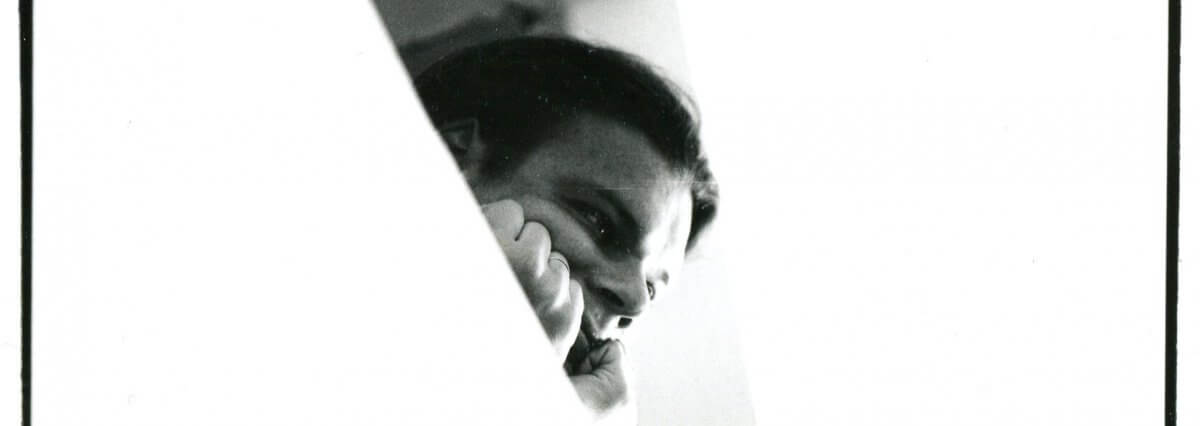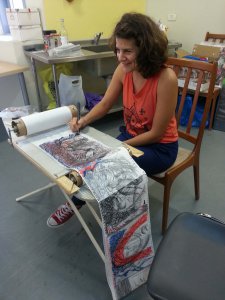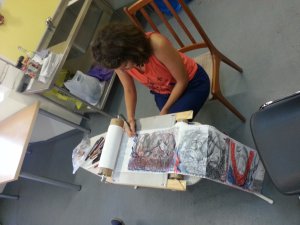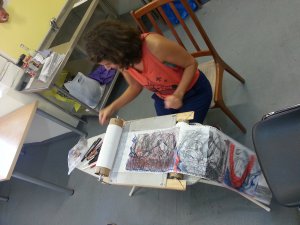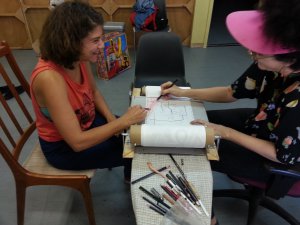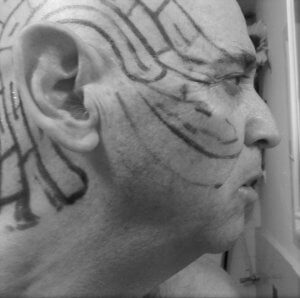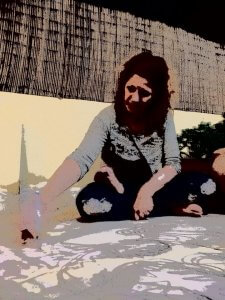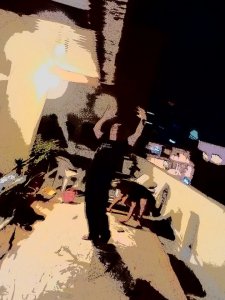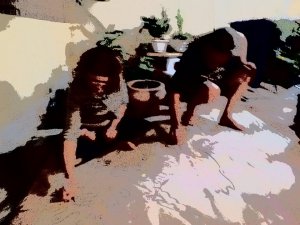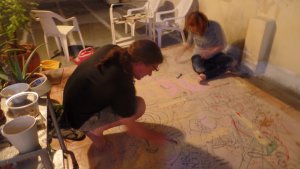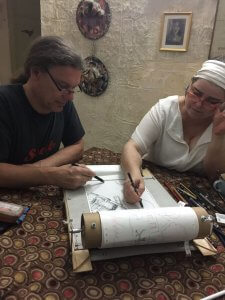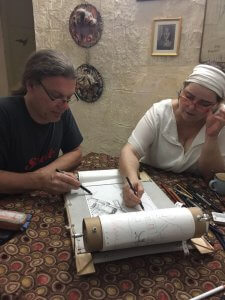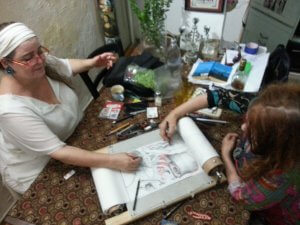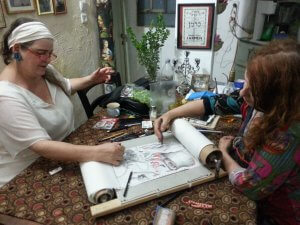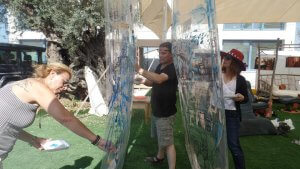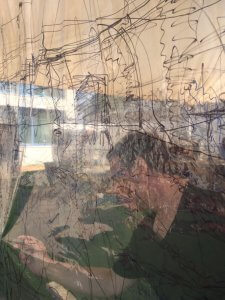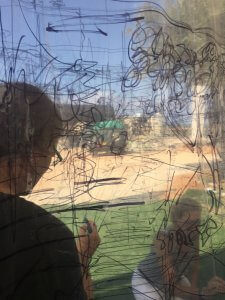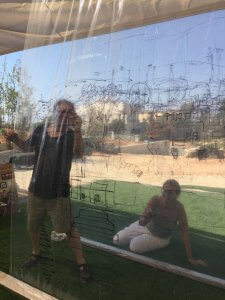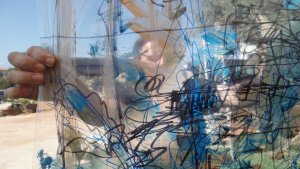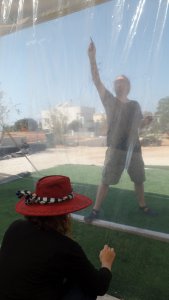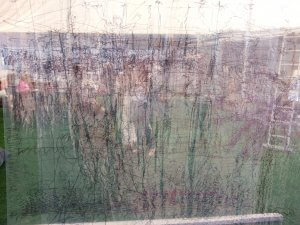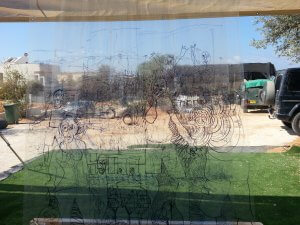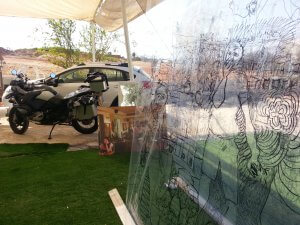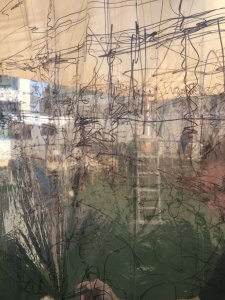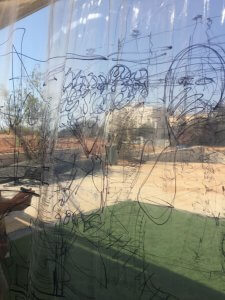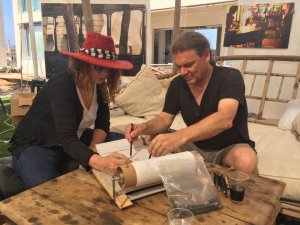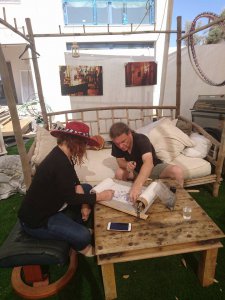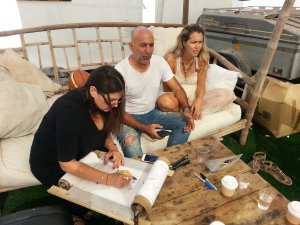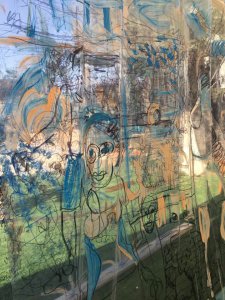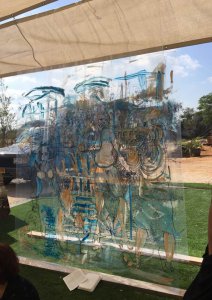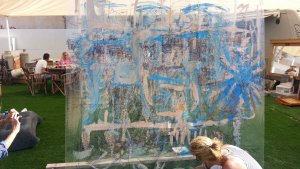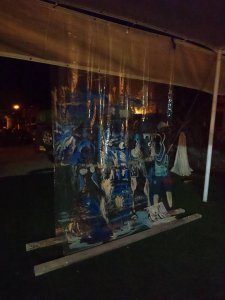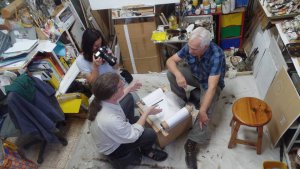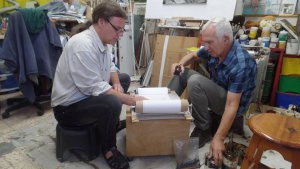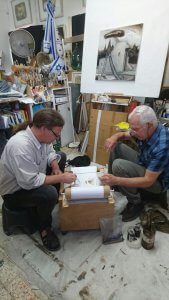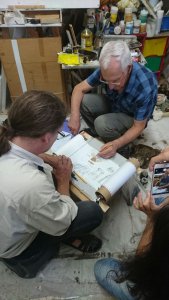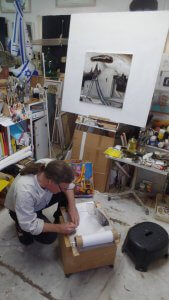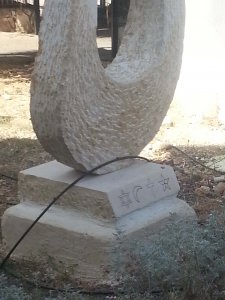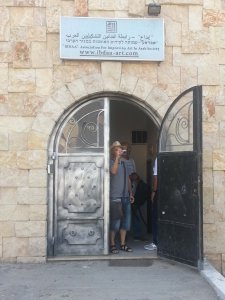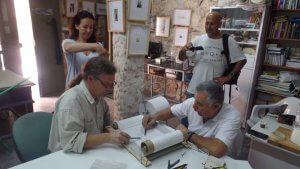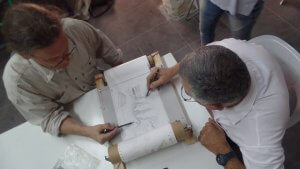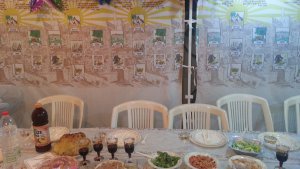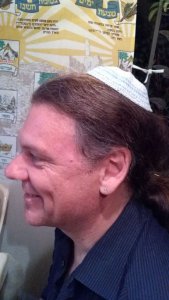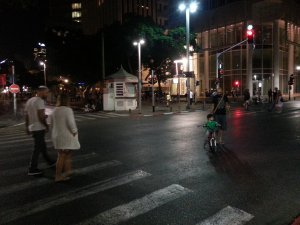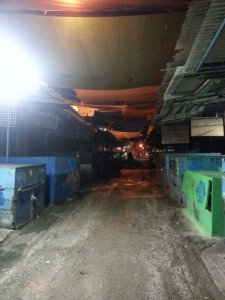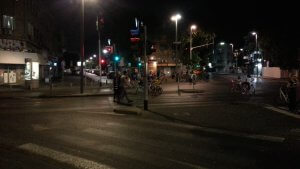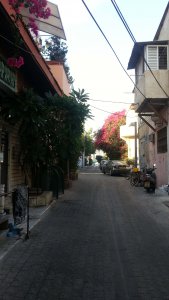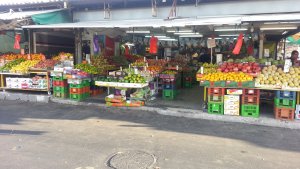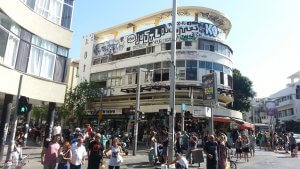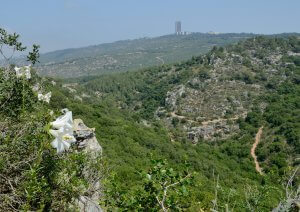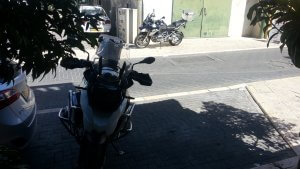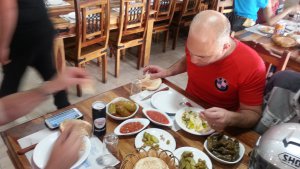Drawing Session with Karin Mendelovici
Category: Diary
Every Day Diary for my friends !
1.Nov
Drawing Performance on the
Rooftop of my new Appartment in Florentine
with Doron and Ophira. Made a long Movie, but meanwile some
of Dorons Fotos .
29.Okt
Drawing Sesion with
Miki Ben-Cnaan and OPHIRA AVISAR
Arsuf 24.Okt
Drawing Session and Performance in Arsuf
with Amir Eshel, Ophira Avisar, Doron Polak and lots of friends.
Drawing Sessions in the North
Drawing Sessions in the North
For another day i went to the North,
together with my friends Sabine, Doron and Amir.
Our first stop took us to Nahariya.
“In the years 1934/35 Nahariya was founded as an agricultural village by a company limited by shares and headed by the agronomist Dr. Selig Eugen Soskin (1873-1959), the civil engineer Joseph Loewy (1885-1949), the financial expert Heinrich Cohn (1895-1976) and the engineer Simon Reich (1883-1941). The company acquired an area of land by purchase from the Arab landowner family Toueini. After ameliorisation and parcelling the plots have been offered to new German Jewish immigrants who had escaped from Nazi persecution. The first two families permanently settled in Nahariya on February 10, 1935, which is now considered the official founding date of Nahariya.[5] After an accumulation of economic, financial and climatic problems the residents soon realized that agriculture was impractical and chose to focus on tourism, taking advantage of the natural surroundings and beaches. During the British Mandate of Palestine, many British officers coming from Khartoum stopped in Nahariya.”
(Text Wikipedia)
We meet Itschak De Lange in his Studio and his Gallery “The Edge”.
As a Second Stop we followed the Invitation of Eliya Beany in
“Kafr Yasif (Hebrew: כַּפְר יָסִיף; Arabic: كفر ياسيف, Kufr Yaseef) is an Arab town in the North District of Israel. It is located 11 kilometers (6.8 mi) northeast of the city of Acre and adjacent to Abu Sinan. The population of Kafr Yasif is largely Christian (57%) with a significant Muslim minority (40%), and a small Druze community.” (Text Wikipedia)
Eliya is engaged in the Museum of the IBDAA (Association for Developing and Encouraging Visual Arts in the Arab Society).
For more information, have a look at their Homepage:
www.ibdaa-art.com/en
We had a worm welcome in the Museum
and went on to Eliya Beanys Studio.
Sukkot 16.Okt
Sukkot
16-23 Okt.
“What is Sukkot?
Sukkot (Feast of Booths or Tabernacles) is one of the three biblically based pilgrimage holidays known as the shalosh regalim. It is an agricultural festival that originally was considered a thanksgiving for the fruit harvest. Sukkot are hut-like structures that the Jews lived in during the 40 years of travel through the wilderness after the exodus from Egypt. As a temporary dwelling, the sukkah also represents the fact that all existence is fragile, and therefore Sukkot is a time to appreciate the shelter of our homes and our bodies.
How is Sukkot celebrated?
Sukkot is celebrated by, first of all, building a sukkah. Jews are required to eat in the sukkah for eight days (seven days in Israel), and some even sleep in the sukkah for the duration of the holiday. The sukkah is decorated and the first day is considered a holy day in which most forms of work are forbidden. The rabbis dictated that arbat ha’minim (four species) should be held together and waved during the holiday. These are based on four plants mentioned in the Bible, and the rabbinic version includes the following: etrog (fruit of the citron tree), lulav (palm frond), hadas (leaves from the myrtle tree), and aravah (leaves from the willow tree). This waving ceremony was performed at the Temple in the ancient world.
The seventh day of Sukkot is called Hoshanah Rabah. On that day in the synagogue Jews circle the room seven times while the arbat ha’minim are held and special prayers are recited.”
(Text from: toriavey)
Yom Kippur 11.Okt.
Yom Kippur
(/jɔːm ˈkɪpər, joʊm, jɒm/; Hebrew: יוֹם כִּיפּוּר, IPA: [ˈjom kiˈpuʁ], or יום הכיפורים), also known as the Day of Atonement, is the most solemn and second only to the Sabbath as the holiest day of the year in Judaism. Its central themes are atonement and repentance. Jewish people traditionally observe this holy day with an approximate 25-hour period of fasting and intensive prayer, often spending most of the day in synagogue services.
(Text: Wikipedia)
That means : No Cars, No Television, No Radio …no Market,
Bar etc.
People are out in the streets and go on bikes or walking.
The synagoges are open 24 hours and serve.
5-8.Okt.
Getting up early, going to Banana Beach for a swim,
having a coffee with some artists, going to carmel
market buying fruits and to the studio start working.
Am i exaggerating …? NO! Thats Artist live in the City!
Ps.: Visiting Galleries in between:
Ha´Kibbutz
Founded by the Kibbutz Movement Federation in the 60’s, the Kibbutz Gallery went through some changes along with the development of Israeli art scene. In the last few years the gallegy has focused its identity and its obligation to art as an inseparable part of the discourse on Israeli culture and art. Alongside its ongoing artistic activity the gallery is currently involved in a combined initiative with some 15 galleries operating in various kibbutzim in the kibbutz movement.
(Text: artbeat)
Meeting with Fatma Shannan at the:
Alfred Gallery,
Alfred Cooperative Institute for Art & Culture is an alternative art space – home to an active and vibrant artist community aimed at introducing contemporary Israeli art and its young creators to art lovers in the local community. The Alfred Institute is the successor of Alfred Gallery, a pioneer in the sphere of cooperative artistic ventures, who’s work became a model for numerous cooperative art galleries in Israel. After 8 years of successful work in south Tel-Aviv, Alfred Institute was establish one year ago, as a space devoted entirely to promoting and supporting young Israeli art.
(Text: Alfred Cooperative Institute)
4.Okt.
Motorbike Trip to Mount Carmel National Park
By invitation of the BMW – Club Israel i made a ride to the North
visiting the park and the Al-Muhraqa at Mount Carmel
“Mount Carmel National Park (Hebrew: פארק הכרמל, Park HaKarmel) is Israel’s largest national park, extending over most of the Carmel mountain range, and containing over 10,000 hectares of pine, eucalyptus, and cypress forest. The park has numerous bicycle and walking paths, dedicated nature reserves, and over 250 archaeological sites inhabited by prehistoric humans.
The park is one of the largest open spaces of northern Israel. It is a typical example of a Mediterranean ecosystem, and includes a rich inventory of geological phenomena, prehistoric artifacts, biodiversity and landscapes. In 1996 it was recognized by UNESCO as a biosphere reserve.”
(Wikipedia)
Al Muhraqa
Text by the Discalced Carmelite Order Muhraqa Monastery
“Al Muhraqa is famous as the site of the Sacrifice of Elijah the Prophet.
It is situated at the N.E. angle of the Mt. Carmel range overlooking the plain of Esdraelon, at an altitude of 482 m. A newly opened road allows the visitor to cover the distance from Haifa to Muhraqa (about 27 kms.) in three-quarters of an hour.
The Episode is dramatically recounted in the Bible (I Kgs. 18). It takes place in the days of the wicked queen Jezebel, daughter of the king of Tyre, who sought to introduce Baal-worship into the northern kingdom, after her marriage to Ahab, king of Israel.
Elijah rose up to resist the persecution. He persuaded Ahab to assemble both people and prophets of Baal on Mount Carmel (I Kgs. 18, 21) where he challenged them to a contest.
After their failure to invoke fire from heaven on the altar and his own success, the false prophets are seized and led down to the river Kishon (I Kgs. 18, 40).
From this detail we learn that the sacrifice took place near the Kishon. From Muhraqa to Haifa, the steepness of the mountain-side excludes the possibility of the event having taken place along the lower reaches of the Kishon.
The Jewish tradition is strongly in favour of Muhraqa. Rabbi Benjamin of Tudela (about 1165) mentions the site of Elijah’s altar on Mount Carmel. Rabbi Jacob of Paris made a visit to the site. They report the existence there of an ancient monument of twelve stones representing the altar of Elijah. Many Christians, including Carmelite travellers from the 17th century onwards, verify the fact. The twelve stones disappeared later, between 1830 and 1850.
The site of the present chapel was formerly occupied by an oratory built of large cut-stones. Rabbi Jacob of Paris (1228) reports that Muslims used to visit the oratory and light candles in honour of Elijah. The building probably dated from pre-Crusader times. If fell into ruin and was replaced by the actual chapel (1883).
The site has been owned by the Carmelite Order for over a hundred years. Recently the chapel was modernized and an altar of twelve stones was erected in memory of the twelve stones used by Elijah to construct his altar according to the Bible (I Kgs, 18, 31).
On the slope leading down to the main road is to be found Bir el-Muhra-qah, which may have furnished the water for the Sacrifice.
Chirbet-ed-Dawabe is close to Muhraqa (near the parking-place): ruins from the Byzantine period have been found on the surface.
Sumaka, farther off, is the site of an extensive Jewish town also from Byzantine times. It is possible that Jews colonized the place because of its proximity to the site of Elijah’s Sacrifice.”
Rest in a drusian restaurant.
Happy New Year
שנה טובה
From Tel Aviv Rolf_Maria
“Rosh Hashanah (Hebrew: רֹאשׁ הַשָּׁנָה, literally “head [of] the year”) is the Jewish New Year. The biblical name for this holiday is Yom Teruah (Hebrew: יוֹם תְּרוּעָה), literally “day [of] shouting/blasting”, sometimes translated as the Feast of Trumpets. It is the first of the Jewish High Holy Days (Hebrew: יָמִים נוֹרָאִים Yamim Nora’im, lit. “Days [of] Awe”) specified by Leviticus 23:23–32, which usually occur in the early autumn of the Northern Hemisphere.
Rosh Hashanah is a two-day celebration, which begins on the first day of Tishrei. Tishrei is the first month of the Jewish civil year, but the seventh month of the ecclesiastical year.
According to Judaism, the fact that Rosh Hashanah is the beginning of the year is explained by it being the traditional anniversary of the creation of Adam and Eve, the first man and woman according to the Hebrew Bible, and their first actions toward the believed realization of humanity’s role in God’s world. According to one secular opinion its origin is in the beginning of the economic year in the ancient Near East, marking the start of the agricultural cycle.
Rosh Hashanah customs include sounding the shofar (a hollowed-out ram’s horn), as prescribed in the Torah, following the prescription of the Hebrew Bible to “raise a noise” on Yom Teruah; and among its rabbinical customs, is the eating of symbolic foods such as apples dipped in honey to evoke a “sweet new year”.”
(Wikipedia.org)
